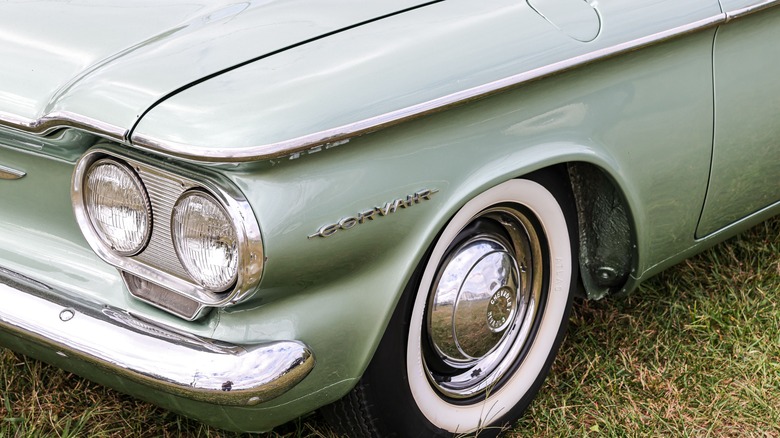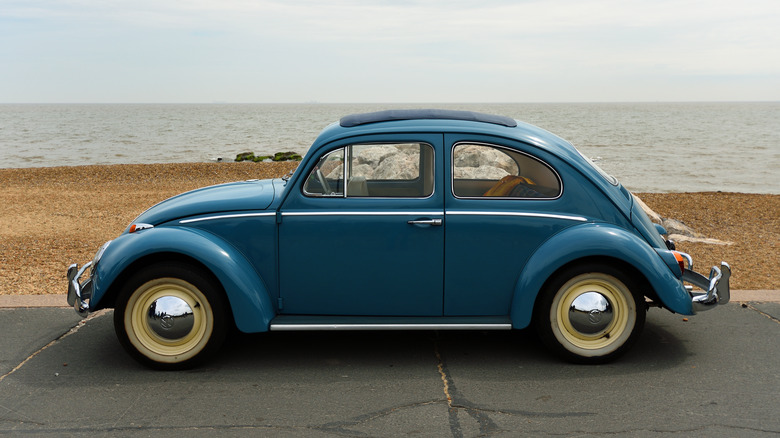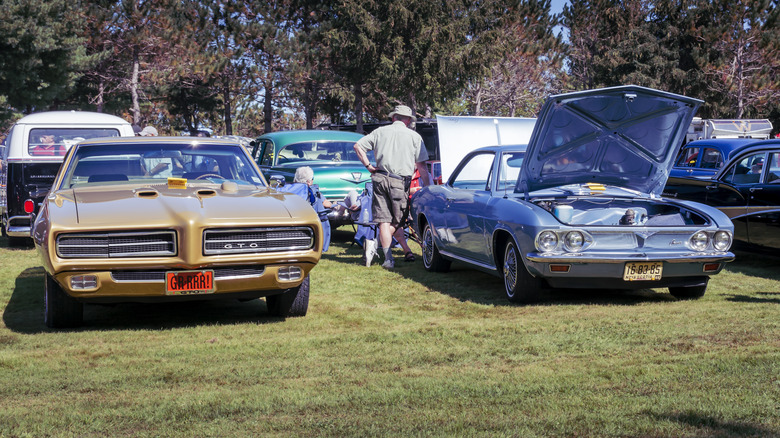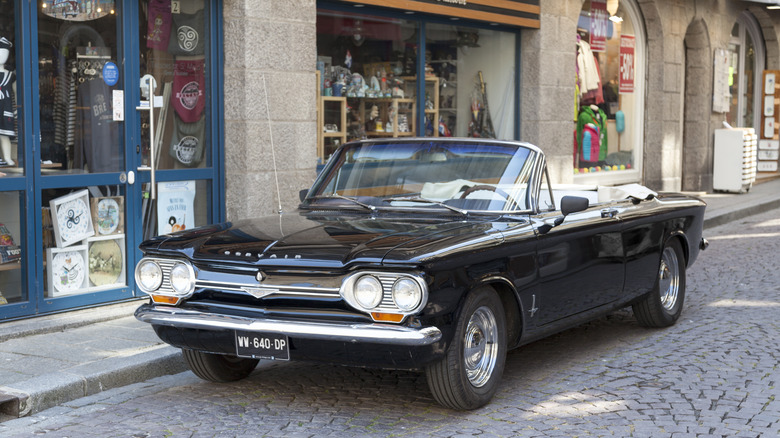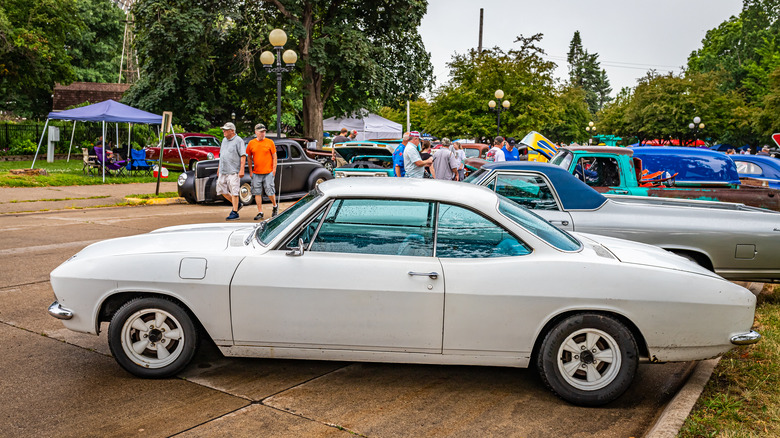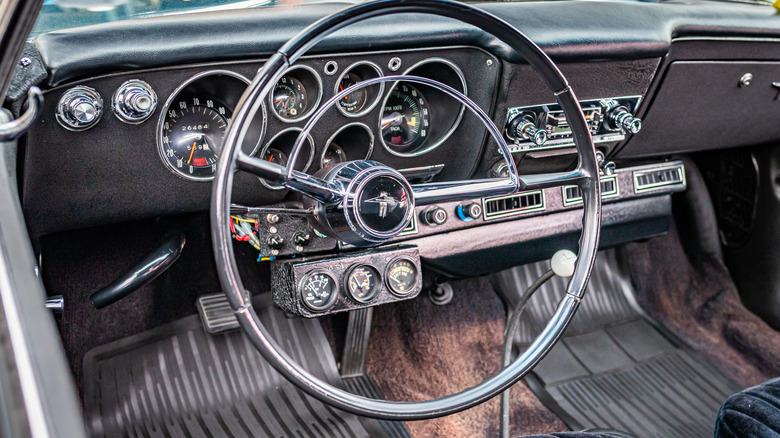Everything Chevy Fans Should Know About The Corvair
Chevrolet Motor Company opened its doors back in November 1911, named for co-founder Louis Chevrolet. Alongside William C. Durant, he kicked off more than a century to date in the ever-competitive auto industry. Iconic Chevy vehicles like the '53 Corvette and '69 K5 Blazer help make up the rich history of the company, as do some other fascinating models. The Corvair is just one example.
The 1960s was an era of truly remarkable vehicles. Enthusiasts will think fondly of the likes of the Ford Mustang, Pontiac GTO, and Chevrolet's own Camaro — all formidable muscle cars. "Big is better" wasn't the only philosophy, though, as compact cars like the Plymouth Valiant were also becoming a big deal. The Corvair eventually became one of the best-known entries in the compact arena, though not always for very flattering reasons.
This in-depth look at the Corvair will explore the model's origins, how it evolved, and what it offered consumers as it did so, as well as the controversy that arose around it and how it influenced the changing automotive industry.
Chasing the Volkswagen Beetle
The emerging compact car industry was something of a curiosity early in the 1960s in the United States. Less powerful but more affordable models were becoming quite popular. As The Saturday Evening Post put it in October 1960, "For the first year since the war, the automakers offered something different from better and costlier caviar. They offered beans — and the beans sold very well."
The Corvair was one of the leaders of this charge in the U.S. It was intended to take advantage of the rise of a similar model from another company. The Volkswagen Beetle debuted in the U.S. in 1949, and though it wasn't exactly an immediate success story, it went on to thoroughly establish itself in the U.S. during the early-to-mid 1960s.
The compact car pie was one that Chevy wanted a slice of. With this in mind, a concept from the 1954 GM Motorama show, an adapted fastback Corvette with modified exhaust vents dubbed the Chevrolet Corvair (Corvette plus Bel-Air), was revisited. The later model that became the actual production Corvair began life there.
The debut of the production Chevy Corvair
The definition of a compact car, of course, needn't be such a specific one. It's not a strict weight class like in boxing, but rather an ideal. For Chevrolet in 1960, that ideal was for a car that didn't break the bank but still outdid the Volkswagen Beetle. To this end, it intended to offer more space while still remaining relatively compact. This was reflected in the specs of the first-generation Corvair.
The original 700 series 1960 Corvair offered 80 horsepower and 125 ft-lb of torque and was equipped with the Chevy Turbo-Air Six 140 engine. Things moved very quickly after that. In 1962, the Spyder Corvair was introduced, capable of outputting 150 horsepower with its turbocharger (an arena Chevrolet hadn't ventured into with such a vehicle before). By the second generation of the Corvair, which arrived in 1965, the family had changed considerably and grown a lot in size and power. This Corvair was more stylish and less angular, with the headlamps being a particular focal point.
Chevy also introduced variations like the Corvair Corsa and Corvair Monza. The latter was a more versatile model that came in a range of configurations, while the former was the pinnacle of the performance Corvair. It could hit 115 mph and up to 180 horsepower in its most formidable trim.
Something different
Industry innovator Edward N. Cole had been the chief engineer on the Corvette project and also had a big influence on the Corvair's design. He had been excited about the new vehicle, he told Automobile Quarterly in the early '70s (via Curbside Classic), because it wasn't simply a smaller vehicle created for the sake of meeting market demand. It was intended to offer something competitors did not. Per Cole, "maneuverability; traction in mud, snow, and ice; easy steering and braking without power assists; a cool passenger compartment; flat floor and a lower profile for a smart styling appearance" were to be among its advantages.
The model was fundamentally unique in its very configuration, too. The air-cooled engine was reminiscent of those employed by the likes of heavy-duty military vehicles such as tanks and aircraft. Air-cooled engines are now a rarity in cars (water-cooled models are predominantly used today) because their need for consistent airflow can leave them more vulnerable to getting too hot while in use. It was a bold move to implement such an engine in the Corvair, but Cole and his team weren't about to shy away from bold moves. After all, if the Beetle could sport an air-cooled engine from its first appearance in the United States to 1979's Super Beetle, why shouldn't the Corvair?
The positioning of that engine, however, would go on to cause some controversy.
Controversy and a bad reputation
The first-generation Corvair, with its engine in the rear and its swing-axle RWD setup, wasn't dissimilar to the Volkswagen Beetle, but it was a real departure from other U.S. models of a similar contemporary caliber like the Plymouth Valiant. Being unique in this way was certain to get people talking, and unfortunately for the Corvair, one of those talkers –- or rather, writers –- was Ralph Nader.
Nader's book "Unsafe at Any Speed: The Designed-In Dangers of the American Automobile" was released in November 1965. It prominently featured the Corvair in a less-than-flattering light. Nader suggested two primary things: That the need for a "budget" car would result in the manufacturers having "priorities which would force them to dilute their engineering standards," and that the rear-engine system contributed to an unreliable driving experience. Nader wrote that the Corvair carried "between 60% and 63% of its weight on the rear wheels," an issue that, he asserted, posed "handling problems considerably in excess of those afflicting the smaller and lighter rear-engined European cars" (excerpt via the American Journal of Public Health).
The book was not an attack on the Corvair in particular. It was intended more to highlight the importance of safety regulations within the auto industry. This it did, leading in its way to the success of the National Traffic and Motor Vehicle Safety Act. Though debate has always existed around how dangerous the Corvair in particular actually was, Nader's writings certainly had an affect on the car's reputation.
The fate of the Corvair
In November 2017, a Hagerty Behind The Wheel episode entitled "Will The Corvair Kill You?" dubbed the vehicle "the most controversial car in history." Ralph Nader's claim, as described by the outlet, was that "a design flaw in the rear suspension made the car likely to flip over when driven in abrupt maneuvers." A rear-mounted engine can make a vehicle more prone to such dangers; balancing issues can cause the back to swing forward during sudden turns in older vehicles in particular. As Time noted in September of 1965, around 85 lawsuits concerning accidents in 1960-63 Corvairs had been registered by then.
The rear suspension system was changed to offer more secure control by 1965, meaning that the risks were primarily associated with the earlier model years. Nonetheless, the sales momentum associated with "Unsafe at Any Speed" surely contributed to at least part of the decline for the vehicle. 1969 was the last year of Corvair, and only 6,000 of that model year would be manufactured.
It was, perhaps, the Ford Mustang's momentum that ultimately doomed the Corvair, more than Ralph Nader. As Lee Iacocca conceded in 1984's "Iacocca: An Autobiography," "We at Ford had nothing to offer to the people who were considering a Monza, but it was clear to us that they represented a growing market." The "pony car" market that the Mustang popularized gave Chevy its own megahit with the Camaro, but the Corvair remains one of the strangest cars ever built by General Motors.
